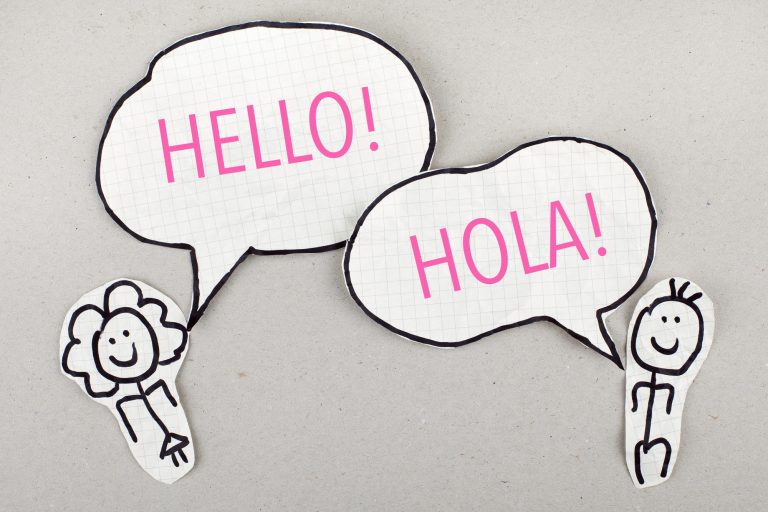Learning Spanish
Getting Comfortable With Speaking Spanish to Others
August 9, 2020

It’s very common for a person learning Spanish to be shy about speaking the language with others, especially if the people they are talking to are native Spanish speakers.
Many of us find it embarrassing. We are self-conscious that our accent will sound strange, and we will make a lot of mistakes.
The good news is that like a lot of things in life, it’s most difficult when you first start. From then on it only gets easier.
It is no surprise that a lot of our customers find it challenging to speak Spanish to others. For many of them, one of the attractive things about our products (StudySpanish.com and the Camino app) is that they are well suited to independent and private learning. You can learn and practice the language on your own, when and where you like.
Of course, the endgame for most of us when studying Spanish is to eventually socialize with other people in that language.
The following are some ways in which you can gradually get yourself to be comfortable speaking Spanish with others.
Speak Spanish Out Loud When Alone
You may already be doing this when studying our lessons or using the Camino app, but the best first step is to get your mouth used to speaking the language.
When reading Spanish examples, practicing conjugations, learning new vocabulary, always try to speak the words and phrases out loud if possible, even if it’s just a murmur under your breath.
I have this silly issue where someone will ask me to do or get something, and I’ll almost always forget about it, unless I say out loud. Saying things out loud don’t just help us practice speaking, it has a way of reinforcing things in our brains.
There are sounds in the Spanish language that are not found in the English language. By practicing these out loud by yourself you will be much better prepared to say them when you speak with others.
There is a delicious food in the region of Spain that Mónica is from called a “bollo preñao” (click to hear). It literally means ‘pregnant bun.’ It’s a bun of bread with a chunk of Spanish chorizo inside.
I absolutely love these, but I massacre the pronunciation of ‘preñao’ so badly that it sounds like I’m imitating a cat meowing. It is a source of great amusement among my family. I’m working on it, but for now I have Mónica order this particular food for me when we are in Spain.
One of the important benefits of doing this is getting accustomed and comfortable with speaking Spanish out loud, even if it’s just to yourself.
Practice With People You Are Comfortable With
If you are lucky enough to have at least a friend or partner that speaks Spanish, then you can get a long way by getting that person to practice with you.

Even if you have a friend that doesn’t speak Spanish, if they are willing to let you use them as your ‘practice dummy’ it will help you get over some of your initial jitters about speaking the language to others.
A friend that is willing to do this is truly a good person, and you should consider buying them a bollo preñao should the opportunity ever arise.
Willing friends aside, another popular method these days is to join a local group that gets together (either physically or virtually) with the intent of speaking to each other in Spanish.
Sites such as MeetUp.com provide a way for groups like this to form and find each other. Depending on where you are there could be multiple Spanish practice groups near you.
Being in a setting with other people like yourself, trying to learn the same language, can be comforting and make it easier for you to get started speaking with others.
Prepare Your Conversation Phrase Toolkit
They say being prepared ahead of time makes you have less anxiety for a situation.

One of the best ways you can prepare for talking with native Spanish speakers is to know what we call the traveler’s phrase toolkit with you at all times.
The toolkit is simply some common expressions that will help you navigate a conversation in Spanish when you are not yet at your highest level of proficiency in the language.
It’ll make more sense to see the phrases themselves, so let’s start.
Asking someone to repeat what they said:
¿Puede repetir, por favor?
(Could you repeat, please?)or less formally
¿Cómo dice?
(What did you say?)
Asking someone to speak a little slower:
¿Podría hablar más despacio, por favor?
(Could you speak slower, please?)
Asking how to say something:
¿Cómo se dice [thing]?
(How do you say [thing]?)Example: ¿Cómo se dice “pen”?
(How do you say “pen”?)Note: [thing] is replaced with the word that you are trying to say in English. Obviously, this only works if the person you are talking to speaks English.
Asking for directions to something:
¿Dónde está [thing]?
(Where is the [thing]?)Example: ¿Dónde está el baño?
(Where is the bathroom?)
Asking how much something costs:
¿Cuánto cuesta?
(How much does it cost?)Example: ¿Cuánto cuesta un bollo preñao?
(How much does a pregnant bun cost?)
There are of course many more phrases that you may want to study and have handy when you talk with Spanish speakers, but these are some common ones.
I wish I could say that all conversations have a happy ending and everything is understood, but you know as well as I do that this isn’t always the case. Sometimes you end up talking with a native speaker that has such a strong accent, or speaks too fast, even after asking them to slow down.
At that point, you must consider using one of the toolkit phrases that is the equivalent of bailing out of the conversation:
Muchas gracias.
(Thank you very much.)Or, if you want to find another person to help you
¿Hay otra persona que puede ayudarme?
(Is there another person that could help me?)
The goal is to have these phrases memorized and ready to use when you need them. That way you will have the minimal phrases needed to find a path through the conversation.
Have Fun With It
We tend to be our own toughest critic.
As I’ve done with this article, try not to take yourself too seriously. It will make things much easier. Nobody is going to expect you to speak perfect Spanish to them.

Think about when someone learning English spoke to you. Did you judge them and get frustrated? Hopefully not. Most people are understanding and patient, and happy that someone is learning their native language.
If you relax and welcome your mistakes as they arrive, you’ll find learning and speaking Spanish to be much more like a relaxing ride on a smooth stream, and less of a whitewater rafting trip through Gringo Canyon.


